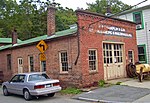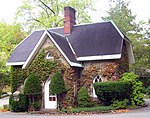The Grove (Cold Spring, New York)

The Grove, also known as Loretto Rest, is a historic house located on Grove Court in Cold Spring, New York, United States. It was built as the estate of Frederick Lente, surgeon at the nearby West Point Foundry and later a founder of the American Academy of Medicine, in the mid-19th century. The Italian-villa design, popular at the time, was by the prominent architect Richard Upjohn. In 2008 it was listed on the National Register of Historic Places. A later renovation replaced its original roof with a mansard roof. After the Lente family sold it, it was purchased by the Roman Catholic Church and converted to a convent. That use ended in 1977 and it has remained vacant since then, suffering the effects of neglect and decay. The surrounding land was subdivided and developed, eliminating much of Upjohn's original landscaping. In the late 2000s the mansard roof was replaced with one more like the original. It is now the property of the village of Cold Spring, which has attempted to preserve but done nothing to restore the estate.
Excerpt from the Wikipedia article The Grove (Cold Spring, New York) (License: CC BY-SA 3.0, Authors, Images).The Grove (Cold Spring, New York)
Grove Court,
Geographical coordinates (GPS) Address Nearby Places Show on map
Geographical coordinates (GPS)
| Latitude | Longitude |
|---|---|
| N 41.418333333333 ° | E -73.950277777778 ° |
Address
Grove Court 12
10516
New York, United States
Open on Google Maps










